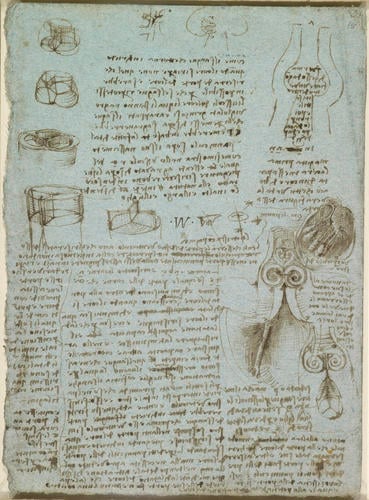-
1 of 253523 objects
The aortic valve c.1512-13
Pen and ink on blue paper | 28.3 x 20.4 cm (sheet of paper) | RCIN 919082
-
Notes on the valves of the heart and the flow of blood within it, with illustrative drawings; a drawing of a mould for the making of a glass model of the aortic valve.
The diagram at top right is a section through ‘a mould of gypsum for blowing up inside with thin glass... But first pour wax into the gate of an ox’s heart so that you may see the true shape of the gate’. Thus Leonardo describes one of his most brilliantly simple anatomical experiments. A couple of years earlier he had used wax injection to determine the shape of the cerebral ventricles (919127); here he applied the same technique to the aortic valve of an ox’s heart. Discovering that immediately above the aortic valve is a widening of the root of the aorta (the sinus of Valsalva), Leonardo made a schematic glass model of that section of the heart (omitting, of course, the cusps of the valve). As noted on 919076v he could then ‘see in the glass what the blood does in the heart when it closes the little doors of the heart’. By pumping water with a suspension of grass seeds through the glass model, Leonardo observed the turbulent eddies in the sinus, which he concluded were responsible for opening out the cusps when blood flow through the valve ceased after each beat of the heart; otherwise, he surmised, reflux of the blood would cause the cusps to crumple (as sketched at upper centre) rather than billowing out to close the valve.
At centre right is a cross-section through the upper part of the left ventricle and sinus of Valsalva, with the lower part of the ventricle sliced through and opened out (though the tubular structure on the wall of the ventricle is the wrong shape for a papillary muscle and in the wrong ventricle to be the moderator band). Leonardo incorrectly shows the wall of the ventricle thickening immediately below the valve: he stated that ‘necessity has provided that the walls of the gateway enlarge, one opposite the other, in such a way that the gateway of the heart is closed by these walls as well as the shutting of the valve orifice by the fine membranes [valve cusps].’ On 919095r, in studying the anal sphincter, Leonardo listed the heart as one of the other ‘six apertures in the skin’, and he evidently believed that there was some sphincter-like action in the closing of the aortic valve, in addition to the (perfectly understood) operation of the cusps.
Immediately adjacent is a longitudinal section through a ventricle, showing the papillary muscles and chordae attached to the cusps of the valve (the sketch is labelled ‘right ventricle’, though the valve appears to be bicuspid). And in the upper left portion of the sheet are a number of diagrams, without any explanatory notes, in which Leonardo muses on the geometrical principles of the three-cusped valves.
Text from M. Clayton and R. Philo, Leonardo da Vinci: Anatomist, London 2012Provenance
Bequeathed to Francesco Melzi; from whose heirs purchased by Pompeo Leoni, c.1582-90; Thomas Howard, 14th Earl of Arundel, by 1630; probably acquired by Charles II; Royal Collection by 1690
-
Creator(s)
Acquirer(s)
-
Medium and techniques
Pen and ink on blue paper
Measurements
28.3 x 20.4 cm (sheet of paper)
Other number(s)
